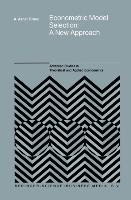Econometric Model Selection
BücherAngebote / Angebote:
This book proposes a new methodology for the selection of one (model) from among a set of alternative econometric models. Let us recall that a model is an abstract representation of reality which brings out what is relevant to a particular economic issue. An econometric model is also an analytical characterization of the joint probability distribution of some random variables of interest, which yields some information on how the actual economy works. This information will be useful only if it is accurate and precise, that is, the information must be far from ambiguous and close to what we observe in the real world Thus, model selection should be performed on the basis of statistics which summarize the degree of accuracy and precision of each model. A model is accurate if it predicts right, it is precise if it produces tight confidence intervals. A first general approach to model selection includes those procedures based on both characteristics, precision and accuracy. A particularly interesting example of this approach is that of Hildebrand, Laing and Rosenthal (1980). See also Hendry and Richard (1982). A second general approach includes those procedures that use only one of the two dimensions to discriminate among models. In general, most of the tests we are going to examine correspond to this category.
Folgt in ca. 5 Arbeitstagen
